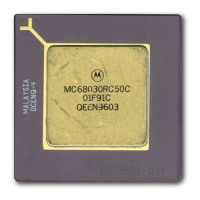Data Organization and Addressing Capabilities
MOTOROLA
MC68030 USER’S MANUAL
2-9
The effective address field may require additional information to fully specify the operand
address. This additional information, called the effective address extension, is contained in
an additional word or words and is considered part of the instruction. Refer to
2.5 Effective
Address Encoding Summary
for a description of the extension word formats.
The notational conventions used in the addressing mode descriptions in this section are:
EA — Effective address
An — Address register n
Example: A3 is address register 3
Dn — Data register n
Example: D5 is data register 5
Xn.SIZE*SCALE — Denotes index register n (data or address), the index size
(W for word, L for long word), and a scale factor (1, 2, 4,
or 8 for no, word, long-word, or quad-word scaling, respectively).
PC — The program counter
d
n
— Displacement value, n bits wide
bd — Base displacement
od — Outer displacement
L — Long-word size
W — Word size
( ) — Identify an indirect address in a register
[ ] — Identify an indirect address in memory
When the addressing mode uses a register, the register field of the operation word specifies
the register to be used. Other fields within the instruction specify whether the register
selected is an address or data register and how the register is to be used.
2.4.1 Data Register Direct Mode
In the data register direct mode, the operand is in the data register specified by the effective
address register field.
OPERAND
GENERATION:
ASSEMBLER SYNTAX:
MODE:
REGISTER:
DATA REGISTER:
NUMBER OF EXTENSION WORDS:
EA = Dn
Dn
000
n
Dn
0
31 0
OPERAND

